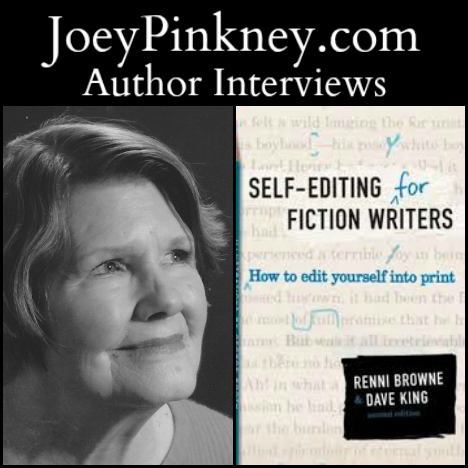JoeyPinkney.com Exclusive Interview
5 Minutes, 5 Questions With…
Renni Browne, author of Self-Editing for Fiction Writers (HarperCollins)
Self-Editing for Fiction Writers shows writers how to handle fiction elements in ways that make their work read like that of a confident, experienced author. Voice, dialogue, point of view, character introduction, and exposition are among these elements, all illustrated with examples and followed by tests and exercises to lock in the chapter’s content.
Joey Pinkney: Where did you get the inspiration to write Self-Editing for Fiction Writers?
Renni Browne: I founded The Editorial Department in 1980, knowing how little developmental and line editing was actually being done at most publishing houses. I began giving self-editing workshops, and when a literary agent (Carole Abel) came to one in New York she said the workshop content was “invaluable” and should be turned into a book. I listened to her.
JP: What sets Self-Editing for Fiction Writers apart from other books in the same genre?
RB: My co-author Dave King and I have a different angle of approach in Self-Editing for Fiction Writers from other craft books. We’re not trying to improve our readers’ grammar or help them come up with a great plot or an unforgettable character.
We focus on issues like how to introduce a character’s back-story without bogging the reader down, how to handle point of view and then handle different points of view within the same chapter, and so on. And Self-Editing for Fiction Writers is the only writers’ book illustrated by New Yorker cartoonist George Booth!
JP: As an author, what are the keys to your success that led to Self-Editing for Fiction Writers getting out to the public?
RB: I’d given workshops around the country, from Oregon and California to Memphis and Manhattan. The Editorial Department had grown fast, was on track to becoming the oldest and largest book-editing firm in the country, and had been written up in Publishers Weekly.
But I think the biggest “key” was our being featured (and photographed) in The New York Times on the company’s tenth anniversary, not long before Self-Editing for Fiction Writers came out..
JP: As an author, what is your writing process? How long did it take you to start and finish Self-Editing for Fiction Writers?
RB: My writing process is to write (if possible) whenever I have an idea and am near my laptop, whenever it occurs to me to change something, whenever I put two thoughts together in a new way. I then usually stay at it quite a while.
I also (with or without an idea) prefer to start writing right after breakfast, when my brain is at its freshest and I’ve had coffee and sustenance. Self-Editing for Fiction Writers took about six months to write.
JP: What’s next for Renni Browne?
RB: I’m writing a second book, Dialogue For Fiction Writers. My co-author this time will be Peter Gelfan, . He’s a published novelist and a long-time fiction and nonfiction editor for The Editorial Department.
Way down the road I want to write a book about the craft of editing. Self-Editing for Fiction Writers helps writers become better writers. My last book will teach editors how to become better editors.
http://www.editorialdepartment.com/
http://www.selfeditingforfictionwriters.com/
https://www.facebook.com/renni.browne
“I’ve been an editor for over fifty years, and I’ve never failed to enjoy it. Every manuscript is different, every writer is different, no two outcomes are exactly the same. So I can’t possibly ever get bored. And when a book I’ve edited gets on the Times bestseller list, or an indie published book sells really well, that is just SO MUCH fun.” ~ Renni Browne
[include file=current-advertisers.html]

